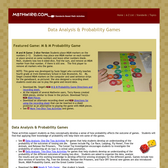Learning Domain: Statistics and Probability
Standard: Use random sampling to draw inferences about a population. Use data from a random sample to draw inferences about a population with an unknown characteristic of interest. Generate multiple samples (or simulated samples) of the same size to gauge the variation in estimates or predictions. For example, estimate the mean word length in a book by randomly sampling words from the book; predict the winner of a school election based on randomly sampled survey data. Gauge how far off the estimate or prediction might be.
Degree of Alignment:
Not Rated
(0 users)
Learning Domain: Statistics and Probability
Standard: Understand that the probability of a chance event is a number between 0 and 1 that expresses the likelihood of the event occurring. Larger numbers indicate greater likelihood. A probability near 0 indicates an unlikely event, a probability around 1/2 indicates an event that is neither unlikely nor likely, and a probability near 1 indicates a likely event.
Degree of Alignment:
Not Rated
(0 users)
Learning Domain: Statistics and Probability
Standard: Approximate the probability of a chance event by collecting data on the chance process that produces it and observing its long-run relative frequency, and predict the approximate relative frequency given the probability. For example, when rolling a number cube 600 times, predict that a 3 or 6 would be rolled roughly 200 times, but probably not exactly 200 times.
Degree of Alignment:
Not Rated
(0 users)
Cluster: Investigate chance processes and develop, use, and evaluate probability models
Standard: Approximate the probability of a chance event by collecting data on the chance process that produces it and observing its long-run relative frequency, and predict the approximate relative frequency given the probability. For example, when rolling a number cube 600 times, predict that a 3 or 6 would be rolled roughly 200 times, but probably not exactly 200 times.
Degree of Alignment:
2 Strong
(4 users)
Cluster: Use random sampling to draw inferences about a population
Standard: Use random sampling to draw inferences about a population. Use data from a random sample to draw inferences about a population with an unknown characteristic of interest. Generate multiple samples (or simulated samples) of the same size to gauge the variation in estimates or predictions. For example, estimate the mean word length in a book by randomly sampling words from the book; predict the winner of a school election based on randomly sampled survey data. Gauge how far off the estimate or prediction might be.
Degree of Alignment:
0.5 Very Weak
(4 users)
Cluster: Investigate chance processes and develop, use, and evaluate probability models
Standard: Understand that the probability of a chance event is a number between 0 and 1 that expresses the likelihood of the event occurring. Larger numbers indicate greater likelihood. A probability near 0 indicates an unlikely event, a probability around 1/2 indicates an event that is neither unlikely nor likely, and a probability near 1 indicates a likely event.
Degree of Alignment:
0.5 Very Weak
(4 users)

Comments